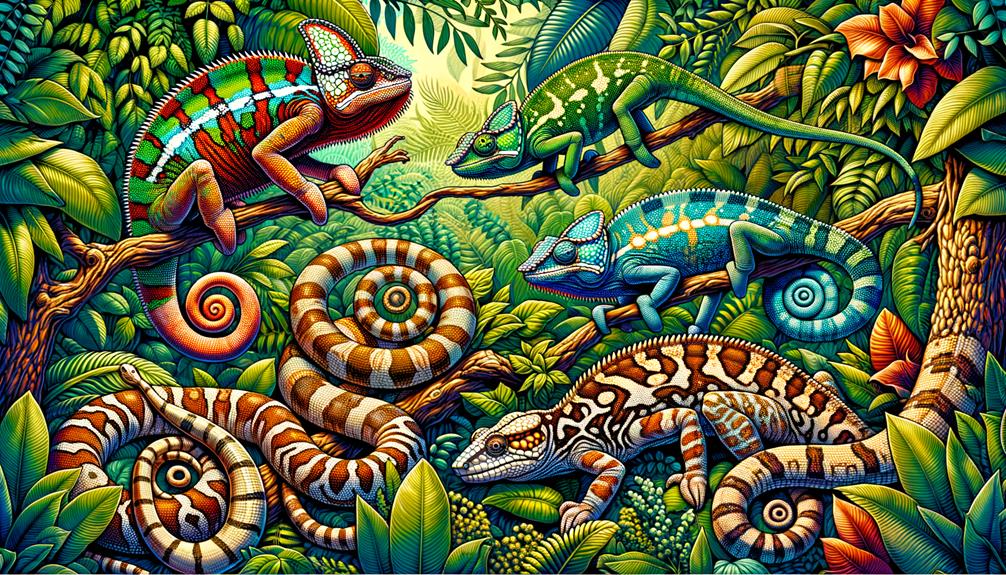When looking at predator-prey interactions through the eyes of reptiles, I’m struck by the intricate adaptations that have evolved to balance survival and resource acquisition. Lizards, for instance, have developed a clever trick called caudal autotomy, or tail-dropping, to evade predators. The size of the predator and the distance to a safe refuge are critical factors that shape escape behaviors. The complexity of the habitat, including vegetation cover and climate, also plays a significant role in these dynamics, influencing vigilance and predation risk. Reptiles have even developed cognitive tactics, such as spatial learning, to detect and respond to threats more effectively. By examining these multifaceted strategies, we can gain a deeper understanding of the dynamic and adaptive world of reptilian interactions.
Key Takeaways
A predator’s body size has a significant impact on a prey’s escape response and antipredator strategies. For instance, lizards have developed caudal autotomy as a key adaptation to escape predators, but this tactic comes at a cost, impairing their locomotion and social status. Notably, lizards living on islands tend to exhibit bolder behaviors due to the reduced presence of predators, which affects the dynamics between predators and prey. The availability of shelter and the complexity of vegetation also play a crucial role in determining the success of predators’ ambush tactics and prey’s ability to seek refuge. Furthermore, reptiles have developed cognitive tactics, such as spatial learning and mimicking behaviors, to avoid predators and enhance their chances of survival.
Evolutionary Adaptations
Lizards have evolved remarkable adaptations to survive and thrive in diverse environments. One such adaptation is caudal autotomy, or tail-dropping, which allows them to escape predators by sacrificing their tail. This morphological trait is a clever way to distract predators and give lizards a chance to flee.
Island-dwelling lizards have developed unique behavioral shifts in response to varying predator presence. For instance, they may reduce their flight initiation distances and become bolder in areas where predators are scarce. These adaptations demonstrate a nuanced response to predation pressures.
In addition to morphological and behavioral adaptations, lizards have also evolved lateralized brain function, which affects their escape decisions. This specialized neural processing enables lizards to detect and react to predators more effectively, optimizing their survival during foraging activities.
These adaptations collectively highlight the complex and dynamic nature of evolutionary processes in lizard species. By developing such traits, lizards strike a delicate balance between foraging efficiency and avoiding predation, ensuring their continued success in diverse environments.
Antipredator Behaviors
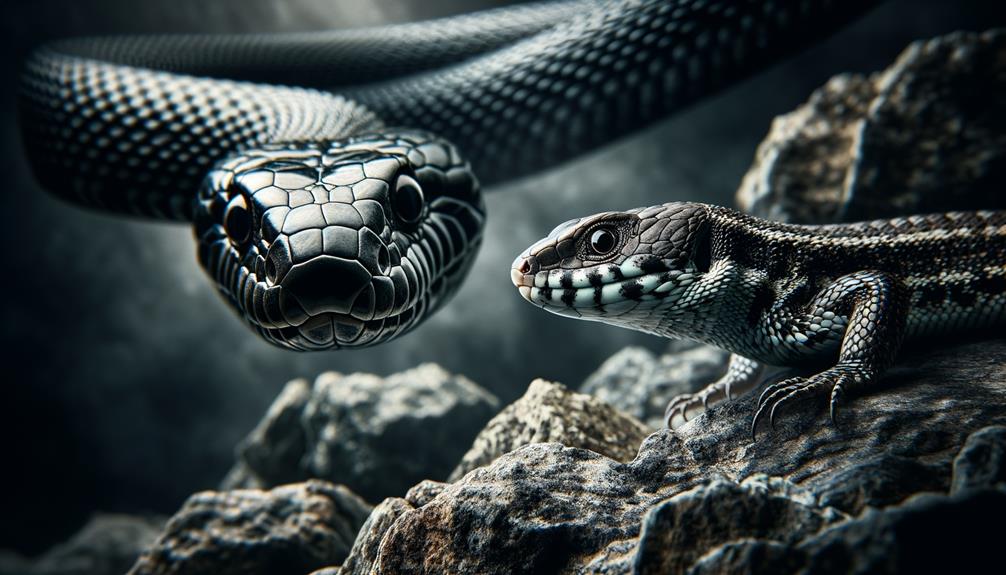
Building on their evolutionary adaptations, many lizard species have developed intricate antipredator behaviors that boost their survival chances in the face of diverse threats. A recent study highlights the critical role these behaviors play in the trophic ecology of reptiles. For example, the sand goanna Varanus gouldii uses caudal autotomy, shedding its tail to evade capture, which significantly impacts the predator-prey dynamic.
Research has found that factors like predator body size and the prey’s reproductive state greatly influence these decisions. Larger predators often pose a greater threat, prompting immediate escape responses. Smaller predators, on the other hand, may not always trigger such drastic measures. The distance to a refuge also plays a key role; lizards closer to safety are more likely to risk a brief confrontation.
The study also reveals how predator-prey size relationships shape these antipredator behaviors. Island lizards, such as the Galapagos marine iguana, have developed unique adaptations in response to novel predators. These multidimensional strategies demonstrate the complexity and sophistication of reptilian antipredator behaviors.
In essence, lizards have evolved various ways to respond to predators, taking into account factors like predator size, reproductive state, and distance to a refuge. These adaptations showcase the remarkable ability of reptiles to adapt and survive in diverse environments.
Habitat Influences
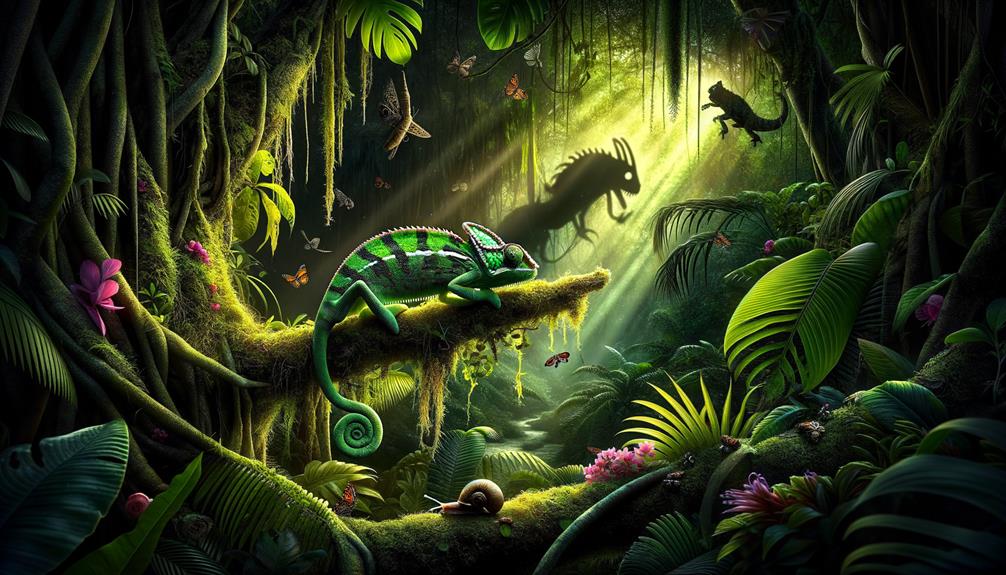
When it comes to reptilian behavior, I look at how shelter availability and hunting grounds influence survival strategies. Climate plays a significant role in shaping behavior patterns, affecting everything from daily activity to seasonal migration. Additionally, resource availability has a ripple effect on not only physical health but also social interactions and territoriality within reptile populations.
Shelter and Hunting Grounds
How do habitat features like vegetation cover and substrate complexity shape the interactions between predators and their prey in reptilian ecosystems? In dense vegetation and complex substrates, predators like snakes and lizards optimize their ambush tactics to maximize their energetic gain from successful hunts. Prey availability is crucial; prey individuals constantly adapt to the presence of predators in their environment. When prey odors are detected, they can signal danger, prompting prey to seek safer refuges. Predators occupy prime hunting grounds, suppressing subordinate prey species and making the survival landscape highly competitive.
Two species have distinct habitat preferences, with prey often selecting burrow sites that minimize exposure to predators. Remarkably, prey may respond positively to odor cues, altering their behavior to avoid detection. Predators use odor trails to locate their next meal, showcasing a complex interplay of sensory inputs and survival strategies. The spatial distribution of microhabitats drives niche partitioning, allowing diverse species to coexist within the same environment. Human-induced changes disrupt these dynamics, affecting the suitability of shelter and hunting grounds. Therefore, habitat features critically influence predator-prey interactions, shaping the evolutionary arms race in reptilian ecosystems.
Climate and Behavior Patterns
Understanding how habitat features influence predator-prey dynamics naturally leads to an examination of how climate factors, such as thermal conditions and precipitation patterns, impact reptilian behavior and survival strategies.
Thermal conditions have a direct impact on reptile activity levels and vigilance. For example, ideal temperatures can increase a lizard’s activity, making it more visible to predators but also increasing its ability to forage and reproduce. On the other hand, extreme temperatures can drive reptiles to seek shelter, affecting their antipredator responses and escape behavior.
Precipitation patterns also play a crucial role. Heavy rainfall can boost vegetation density, providing more hiding spots and altering the perceived risk of predation. However, excessive rainfall might reduce activity levels due to lower temperatures and damp environments, forcing reptiles to be more selective in their refuge use and escape decisions.
Seasonal shifts, particularly in reproductive states, further complicate these dynamics. During breeding seasons, reptiles like snakes often face a trade-off between predator avoidance and reproductive activities. This can lead to altered vigilance and escape behavior, as the urgency of reproduction sometimes outweighs the immediate risk of predation.
Urbanization disrupts these natural patterns by modifying habitat features and reducing perceived risk, which can lead to suboptimal antipredator responses. To comprehend reptilian survival strategies, it’s essential to understand these intricate connections between climate and behavior.
Resource Availability Impact
In exploring the impact of resource availability on reptilian behavior and survival, it becomes clear that habitat structure and vegetation complexity play a crucial role in shaping predator-prey interactions. Habitats with complex structures and abundant hiding spots can reduce the risk of predation for prey species by making it harder for ambush predators like snakes and lizards to hunt. On the other hand, open habitats give active hunting reptiles an advantage. This dynamic is particularly evident when considering how two species share burrows; research has shown that small mammals occupying these burrows tend to stay close to home, reducing their vulnerability to predators.
In ecosystems where a top predator reptile dominates, it can suppress other predators, indirectly influencing the abundance and behavior of its prey. For example, the presence of an apex reptilian predator can alter how prey species respond to different scents, which in turn affects their habitat use. Human activities like urbanization and agricultural expansion simplify habitat structures, disrupting these delicate dynamics. This is particularly problematic for reptiles adapted to complex environments, making it harder for them to catch small mammal species. For the first time, we’re seeing how human-induced changes disrupt the intricate relationships between predators and prey, highlighting the need for habitat conservation.
Size Relationships
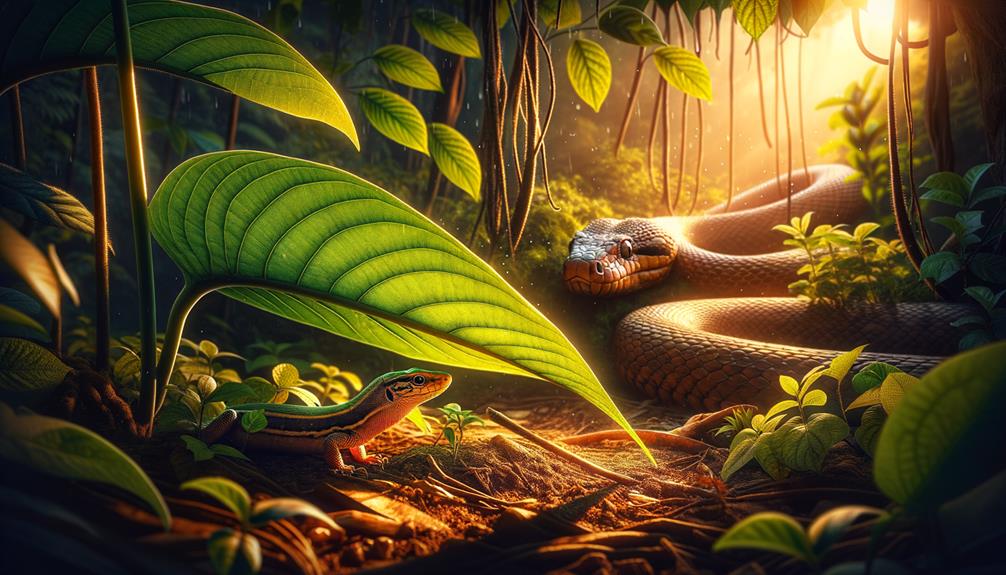
Examining the intricate dynamics of size relationships in predator-prey interactions provides significant insights into the evolutionary pressures shaping vertebrate species. Research at the School of Life and Environmental Sciences suggests that smell plays a crucial role in predator-prey dynamics, particularly in arid central environments where visual cues are limited. Prey individuals often detect predatory odour cues, which serve as vital signals indicating the presence of an apex predator. These olfactory cues can trigger escape behaviours, highlighting the importance of smell in survival strategies.
In Africa’s diverse ecosystems, predator-prey size relationships reveal distinct patterns of size-dependent predation risk. Typically, larger predators target smaller prey species, leading to various ecomorphological adaptations. For example, the island radiations of Anolis lizards demonstrate how body size influences predator-prey dynamics and escape decisions. These lizards have evolved specific adaptations to optimize their chances of survival against predators of different sizes.
The decision-making process in prey species is also heavily influenced by the approaching predator’s body size. When a predator is substantially larger, the prey is more likely to flee, emphasizing the critical role of size in shaping these interactions and evolutionary outcomes.
Caudal Autotomy

Caudal autotomy, the remarkable ability of lizards to shed their tails to escape predators, has long fascinated researchers due to its significant impact on survival and evolutionary dynamics. This anti-predator strategy is influenced by habitat structure and predator type, with notable differences between ground-dwelling and arboreal species. For instance, ground-dwelling lizards often face terrestrial predators, making caudal autotomy a vital survival mechanism in open environments. In contrast, arboreal species may employ this strategy differently due to their complex three-dimensional habitats and predators, such as birds.
After shedding their tails, lizards undergo significant physiological and behavioral adjustments. Initially, locomotion is impaired, necessitating adaptive changes that eventually restore mobility. Reproduction may also be affected, as energy resources are diverted towards tail regeneration rather than mating or offspring production. Social behavior can also shift; tailless lizards might experience altered status within their social hierarchies, influencing interactions and territorial disputes.
The evolutionary significance of caudal autotomy lies in its role as an effective anti-predator mechanism. By enabling escape and subsequent survival, tail shedding guarantees that lizards live to reproduce, perpetuating genes that favor this remarkable trait. As a result, caudal autotomy offers a compelling model for examining the ecological and evolutionary consequences of morphological adaptations.
Cognitive Tactics
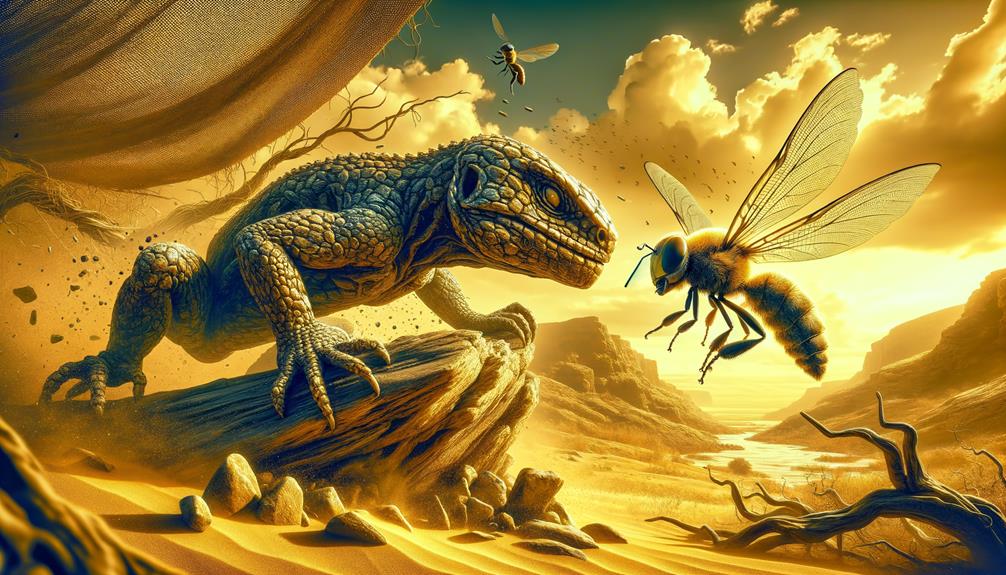
Reptiles have developed a range of clever tactics to survive in their environments. For instance, garter snakes use spatial learning to associate specific visual cues with predator presence, allowing them to avoid potential threats. Desert iguanas, on the other hand, excel at remembering the locations of ideal basking and foraging sites, which helps them regulate their body temperature and find food more efficiently.
Crocodilians have taken their cognitive abilities to the next level by learning from each other. Young crocodiles observe and mimic the hunting techniques of older, more experienced individuals, which helps them hone their skills over time. This social learning is crucial for their survival and hunting efficiency.
Lizards have developed a remarkable ability to detect predators and prey using both chemical and visual cues. Their keen senses allow them to respond quickly and adapt to their environment, ensuring they can take advantage of opportunities and avoid threats. Overall, the cognitive abilities of reptiles, including spatial learning and sophisticated problem-solving, demonstrate a high degree of behavioral flexibility that is essential for thriving in their ecological niches. These tactics enable reptiles to flourish despite the constant environmental challenges they face.
Frequently Asked Questions
What Are 3 Examples of Predator Prey Interactions?
Three examples of predator-prey interactions are sand goannas hunting small mammals, spectacled salamanders and centipedes avoiding each other, and Vipera graeca vipers preying on flightless orthopterans. These interactions showcase the complex dynamics of ecosystems and the adaptive behaviors that have evolved in response.
What Is the Predator Prey Interaction Theory?
The predator-prey interaction theory is a dynamic game of strategy, where both predators and prey constantly adapt to outmaneuver each other. As predators evolve more effective hunting tactics, prey develop new defenses, influencing the diversity of species, population dynamics, and the structure of ecological communities.
What Is the Interaction Between Predator and Prey Called?
The interaction between predator and prey is a complex relationship that profoundly shapes ecosystems. This dynamic influences population dynamics, evolutionary pathways, and the delicate balance within natural communities, making it a fascinating topic to explore.
What Are Predator Prey Relationship Patterns?
Did you know that predator size plays a significant role in prey escape decisions, influencing around 70% of them? The dynamics of predator-prey relationships are complex, with ecological factors like habitat and predator type shaping these interactions and triggering adaptive responses in the prey.


